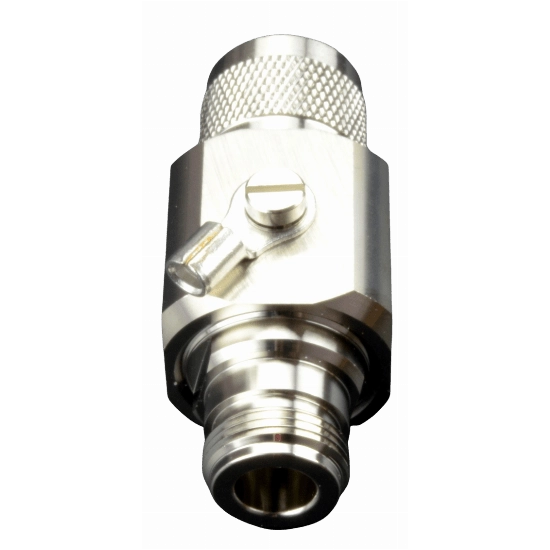Surge Protection Device - N-Type, Male to Female
Product Code: PROSPD11N
- Easy installation
- Brass metal casing
- Strong protection and high reliability
- High discharge capability
- IP20 rated
Product Description
Coaxial N-Type Surge Protection Device
Our coaxial N-Type SPD shields your aerial system's devices from power surges. Equipment such as TVs, amplifiers, and receiver boxes would benefit from having this line of defense.
What is a Surge Protection Device (SPD)?
Surge Protective Devices (SPD) are used to protect installations from electrical power surges known as “transient overvoltages”.
They are also used to protect sensitive electronic equipment connected to the installation, such as computers, televisions. Any equipment with sensitive electronic circuitry can be vulnerable to damage by transient overvoltages.
The effects of a surge can result in either instant failure or damage to the equipment only evident over a longer period of time. It is important to remember that protecting the electrical installation alone, and not the other services, could leave another route for transient voltages to enter the installation.
There are three different types of Surge Protective Devices:
Type 1 SPD: installed at the origin, e.g. main distribution board.
Type 2 SPD: installed at sub-level.
Type 3 SPD: installed close to the protected load. They must only be installed as a supplement to Type 2 SPD.
The PROception range of SPDs are all Type 2.
What causes transient overvoltages?
Natural transient overvoltages mostly occur due to direct lightning strikes but can also occur from indirect strikes too.
Man-made transients appear due to the switching of motors and transformers, along with some types of lighting. Historically this has not been an issue within domestic installations but more recently, installations are changing with the advent of electric vehicle charging, heat pumps have made transients much more likely to occur within domestic installations.
How do SPDs work?
The gas discharge tube (GDT) is sealed with ceramic and its interior consists of two or more metal electrodes with gaps filled with the inert gases, argon and neon. As the overvoltage passes through, it arcs between the electrodes, allowing current to flow to ground, thus protecting your devices.
Technical Information:
| Electrical Characteristics | ||||||
| Product Code | PROSPD11N | |||||
| Connection Type | N-Type | |||||
| Interface Type | Male to Female | |||||
| Gas Discharge Tube Arrester | 90V/230V/350V | |||||
| Frequency Range | DC - 1GHz | |||||
| Operating Current | None | |||||
| Max. Discharge Current (8/20μs) (Imax) | 10KA | |||||
| Insertion Loss | <0.2dB | |||||
| Insulation Resistance | ≥1000MΩ | |||||
| Impedance | 75Ω | |||||
| Max. RF Throughput | 50W | |||||
| Input Power | <20W | <50W | <100W | <200W | <400W | <500W |
| Initial Discharge Voltage | ≥50V | ≥70V | ≥120V | ≥190V | ≥280V | ≥280V |
| Protection Mode(s) | Common Mode | |||||
| Mechanical Characteristics | ||||||
| Technology | Gas Discharge Tube (GDT) | |||||
| Connection to Network | Connector Male to Female | |||||
| Mounting | Feedthrough | |||||
| Housing Material | Brass HPb59-1 GB4425-84 | |||||
| Working Temperature (°C) | -40 to 85 | |||||
| Degree of Protection | IP20 | |||||
| Failsafe Mode | Short-Circuit | |||||
| Disconnection Indicator | Transmission Interrupt | |||||
Technical Specification
Width
30mm
Depth
30mm
Height
70mm
Weight
0.17kg
03/10/2025
01/10/2025
Delivered on-time without hitch.
25/09/2025
Excellent
23/09/2025
All good
14/09/2025
Spot on with everything needed good
Google Company Reviews
05/12/2025
Initially wrong products were picked and despatched. Replacements sent as soon as I made contact. Eventually good service
02/12/2025
Had to ring to see why I hadn't received my order, was told one item was out of stock, said they didn't know when they would receive the item but that same day it was sent to the courier, then still took another four days before I received my package,very poor packaging,hard to get into, one pole badly scratched and the other has a sticker on it that I cannot remove.
28/11/2025
Excellent, fast service and the aerial pole arrived in 100% condition.
22/11/2025
04/11/2025
item not received after a number of days. Reported by landline to Blake Head Office this morning.. Request replacement at no expense to myself. Please advise. Thanks. Anthony Ernest.








 Quick Add
Quick Add






















Exactly what I needed and delivered when said great team